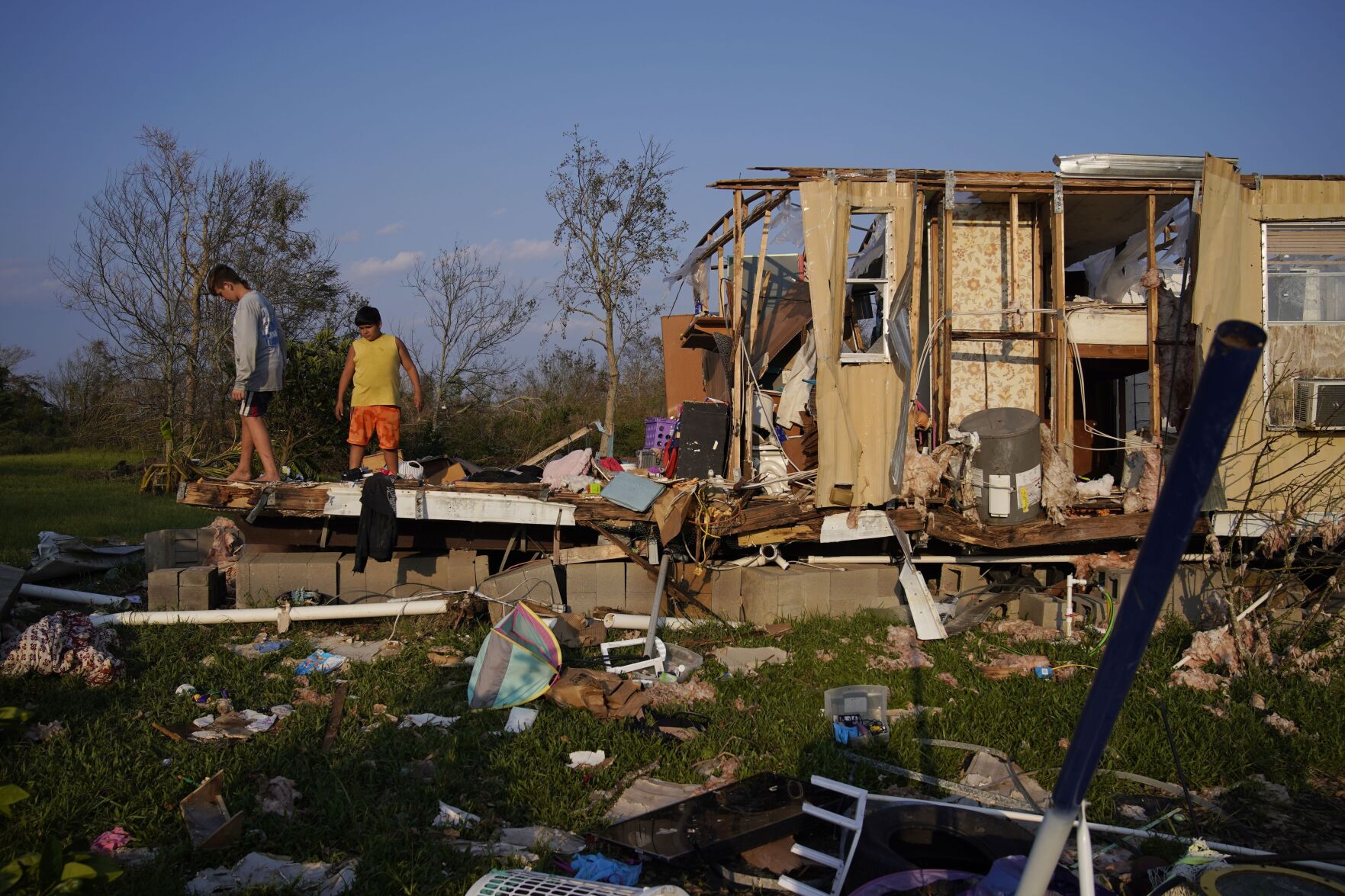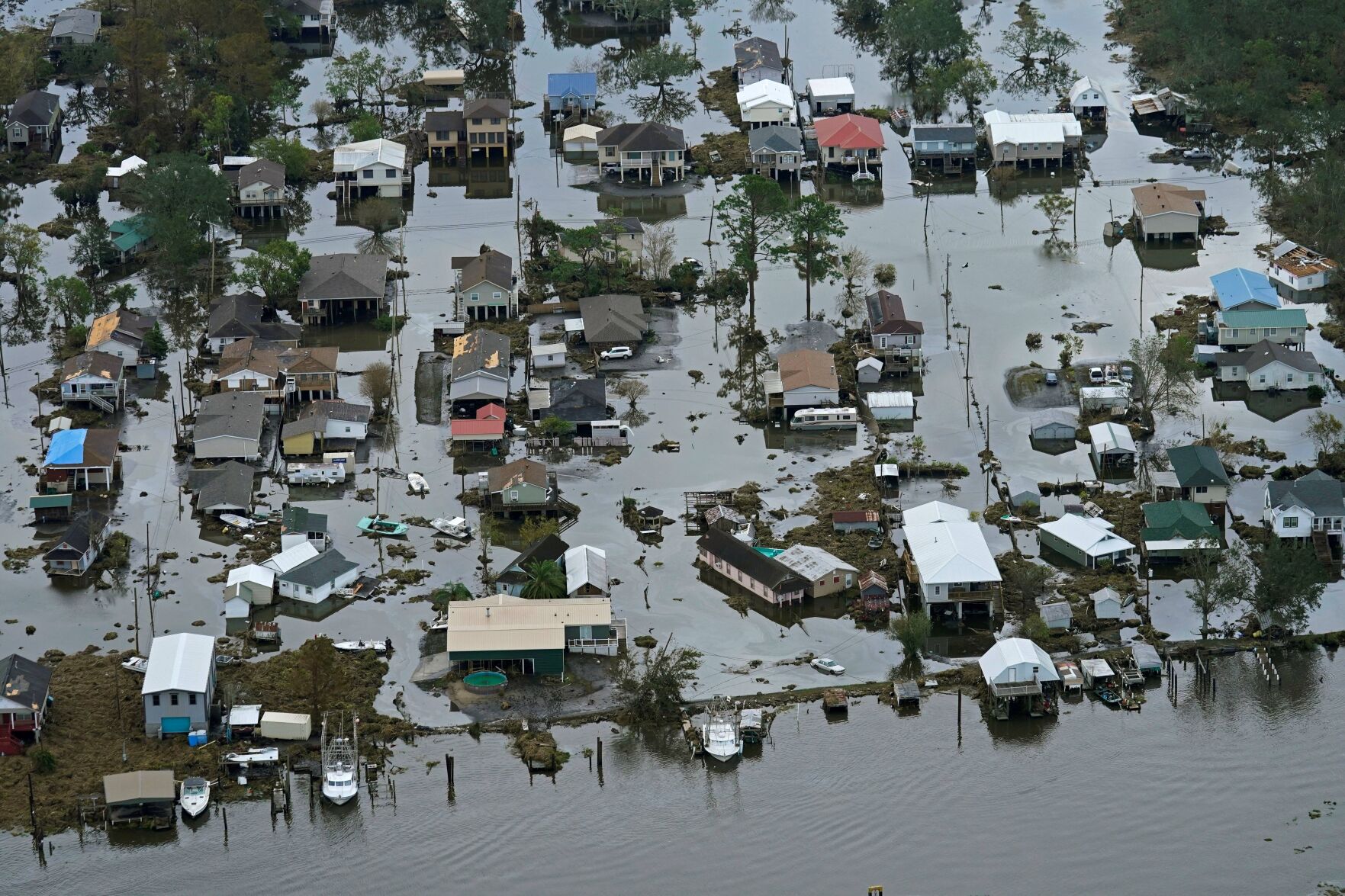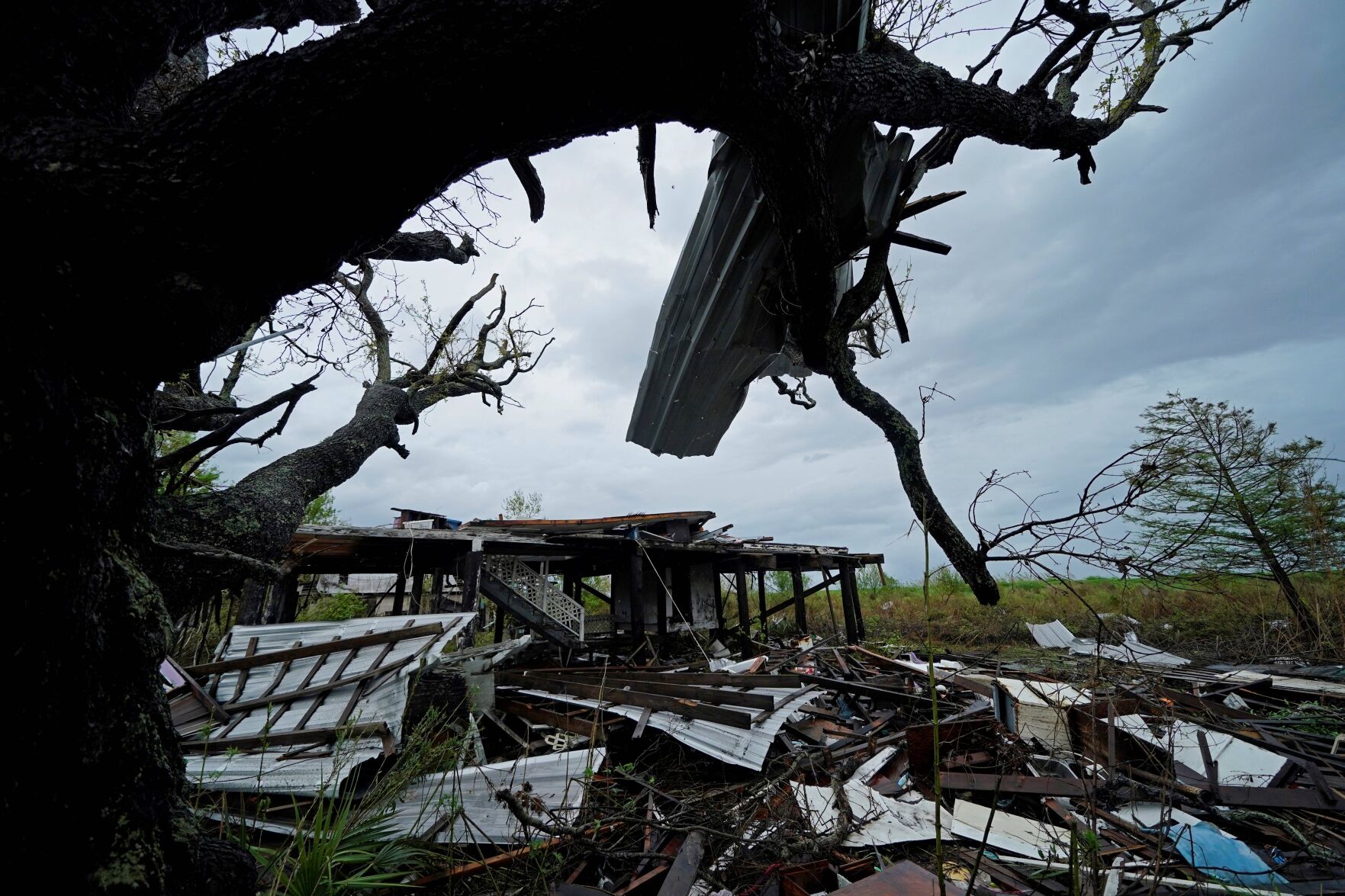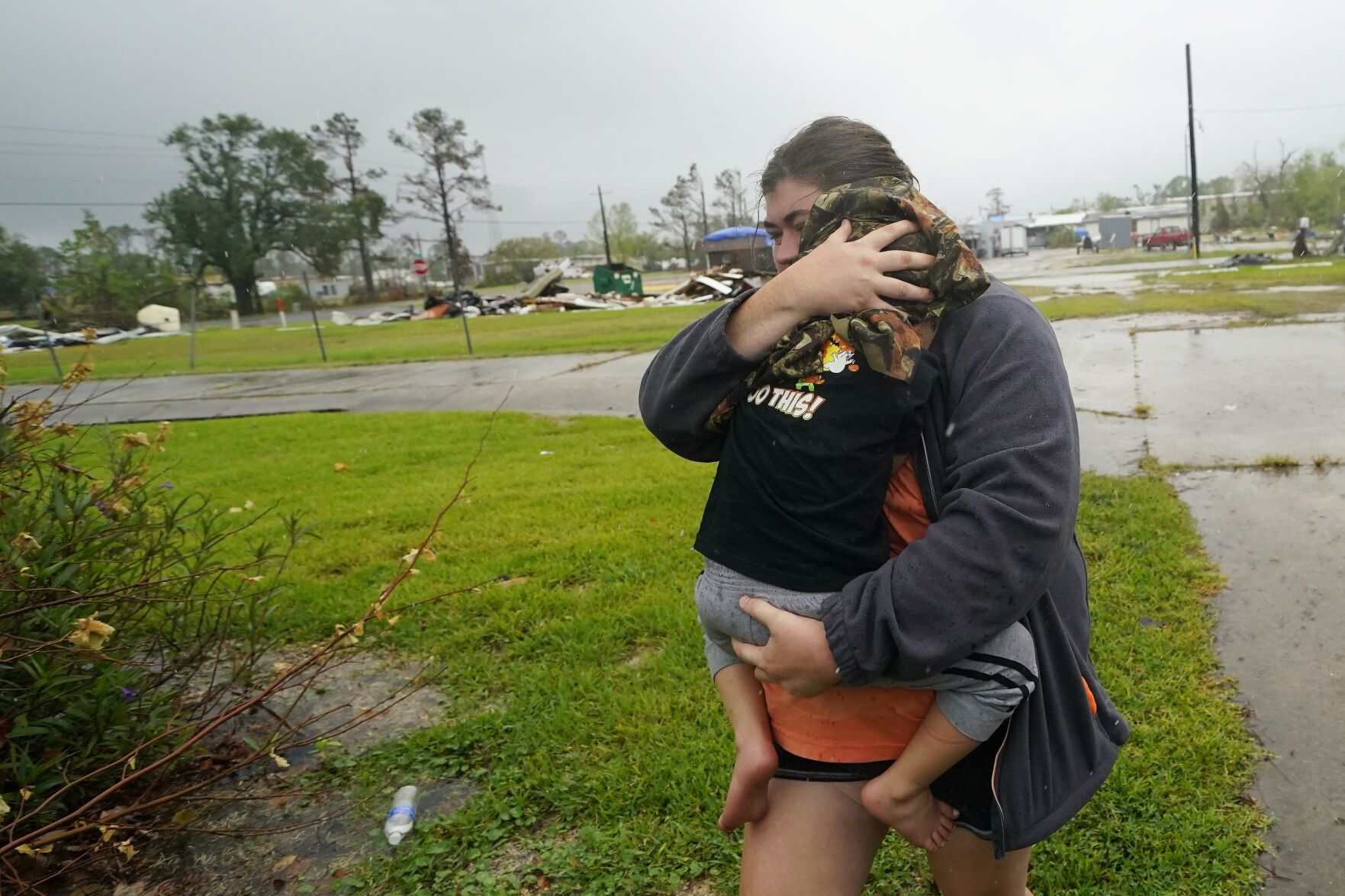What used to be a rare one-two punch of consecutive hurricanes hitting about the same place in the United States weeks apart seems to be happening more often, and a new study says climate change will make back-to-back storms more frequent and nastier in the future.

John Locher, Associated Press
Aiden Locobon, left, and Rogelio Paredes look through the remnants of their family's home destroyed by Hurricane Ida on Sept. 4, 2021, in Dulac, La.
Using computer simulations, scientists at Princeton University calculate that the deadly storm duet that used to happen once every few decades could happen every two or three years as the world warms from the burning of coal, oil and natural gas, according to a study in Monday’s Nature Climate Change.
Louisiana and Florida residents have already felt it.
In 2021, major Hurricane Ida blasted Louisiana with 150 mph winds. Just 15 days later a weakening Nicholas came nearby, close enough for its wind, rain and storm surge to add to the problems, said study co-author Ning Lin, a risk engineer and climate scientist at Princeton. Her study looked at not just the storms but the problems that back-to-back hurricanes caused to people.

Gerald Herbert, Associated Press
Floodwaters slowly recede in the aftermath of Hurricane Ida on Sept. 1, 2021, in Lafitte, La.
The Ida-Nicholas combo came after Louisiana was hit in 2020 by five hurricanes or tropical storms: Cristobal, Marco, Laura, Delta and Zeta. Laura was the biggest of those, packing 150-mph winds.
After Laura, relief workers had set up a giant recovery center in a parking lot of a damaged roofless church when Delta approached, so all the supplies had to be jammed against the building and battened down for the next storm, said United Way of Southwest Louisiana President Denise Durel.
“You can’t imagine. You’re dumbfounded. You think it can’t be happening to us again,” Durel recalled 2 ½ years later from an area that is still recovering. “The other side of it is that you can’t wish it upon anyone else either.”
Florida in 2004 had four hurricanes in six weeks, prompting the National Oceanic Atmospheric Administration to take note of a new nickname for the Sunshine State — “The Plywood State,” from all the boarded-up homes.
“We found a trend,” Lin said. “Those things are happening. They’re happening more often now than before.”
There’s a caveat to that trend. There haven’t been enough hurricanes and tropical storms since about 1950 – when good recordkeeping started – for a statistically significant trend, Lin said. So her team added computer simulations to see if they could establish such a trend and they did.

Gerald Herbert, Associated Press
Storm clouds from Tropical Storm Nicholas are visible behind homes of the Native American community of Isle de Jean Charles, La., that were destroyed Sept. 14, 2021, by Hurricane Ida, Sept. 14, 2021.
Lin’s team looked at nine U.S. storm-prone areas and found an increase in storm hazards for seven of them since 1949. Only Charleston, South Carolina, and Pensacola, Florida, didn’t see hazards increase.
The team then looked at what would happen in the future using a worst-case scenario of increasing carbon dioxide emissions and a more moderate scenario in line with current efforts worldwide to reduce greenhouse gases. In both situations, the frequency of back-to-back storms increased dramatically from current expectations.
The reason isn’t storm paths or anything like that. It’s based on storms getting wetter and stronger from climate change as numerous studies predict, along with sea levels rising. The study looked heavily at the impacts of storms more than just the storms themselves.
Studies are split on whether climate change means more or fewer storms overall, though. But Lin said it’s just the nastier nature and size that increases the likelihood of back-to-back storms hitting roughly the same area.

Gerald Herbert, Associated Press
Danielle Fontenot runs to a relative's home in the rain with her son Hunter ahead of Hurricane Delta on Oct. 9, 2020, in Lake Charles, La.
Any increased frequency in sequential storms in the past was likely due to a reduction in traditional air pollution rather than human-caused climate change; when Europe and the United States halved the amount of particles in the air since the mid-1990s it led to 33% more Atlantic storms, a NOAA study found last year. But any future increase will likely be more from greenhouse gases, said two scientists who weren’t part of the study.
“For people in harm’s way this is very bad news,” University of Albany hurricane scientist Kristen Corbosiero, who wasn’t part of the study, said in an email. “We (scientists) have been warning about the increase in heavy rain and significant storm surges with landfalling TCs (tropical cyclones) in a warming climate and the results of this study show this is the case.”
Corbosiero and four other hurricane experts who weren’t part of the study said it made sense. Some, including Corbosiero, say it is hard to say for sure that the back-to-back trend is already happening.
Colorado State University hurricane expert Phil Klotzbach said the emphasis on worsening effects on people was impressive, with storm surge from rising seas and an increase in rainfall from warmer and stronger major hurricanes.
“You have to have faith and be able to move forward. You’ve just got to be in constant motion,” Durel, the Louisiana United Way president, said. “Our neighbors mean much more than wallowing in aggravation.”
-
The big reason Florida insurance companies are failing isn’t just hurricane risk — it’s fraud and lawsuits
Joe Raedle/Getty Images)
On the afternoon of Sept. 28, Hurricane Ian made landfall in Southwest Florida as a Category 4 storm. Winds reached 150mph, just a few miles shy of a Category 5 classification. Only four Category 5 hurricanes have ever hit the U.S., the most recent one being Hurricane Michael in 2018.
By the following morning, at least 2.5 million households in Florida had lost power. Storm surges caused life-threatening floods throughout West and Central Florida, the hurricane destroyed roads, bridges, and houses, and excessive rains caused inland rivers to break record flood levels. Ian continued to move up the Atlantic Coast before making landfall again, this time as a Category 1 storm, in South Carolina.
A single hurricane can cause billions of dollars in damage, not to mention the physical and emotional toll it takes on those in its path. Over the past five years, hurricanes Laura, Ida, Harvey, Irma, and Maria have caused extensive damage and death tolls. The full impact of Ian will come into sharper focus in the coming days and weeks.
Hurricane recovery plans include everything from the basic distribution of food and water supplies to rebuilding highways, energy grid improvements, and far-reaching infrastructure upgrades. Recovering after extensive hurricane damage can take years and can sometimes be sidetracked by additional storms.
2022's Atlantic hurricane season, which lasts roughly from June 1 to Nov. 30, has been quieter than meteorologists predicted. Before Ian, three other hurricanes formed, two of which dissolved before landfall. Hurricane Fiona, a storm that first made landfall in Puerto Rico on Sep. 18 as Category 1 and wrought damage across the Caribbean as it strengthened, was the season's first major hurricane. Still, the span between August and September represents just part of the peak range for Atlantic hurricanes, with October's forecast not yet clear.
Stacker took a look at NOAA data to extrapolate the costliest hurricanes of all time. In this gallery, you'll find the category of the storm, the year it occurred, and how much damage it caused. Tropical storms, defined as cyclones with winds less than 74 mph, are not included in the analysis. The data includes hurricanes that impacted Puerto Rico and the U.S. Virgin Islands, and the cost listed is in current U.S. dollars which have been adjusted for inflation. This data also addresses the cost of these hurricanes to the U.S. (and its territories), not to other countries or regions. More information on the methodology can be found at the National Hurricane Center.
Read on for the costliest hurricanes of all time.
You may also like: Fastest-warming states since 1970

Joe Raedle/Getty Images)
On the afternoon of Sept. 28, Hurricane Ian made landfall in Southwest Florida as a Category 4 storm. Winds reached 150mph, just a few miles shy of a Category 5 classification. Only four Category 5 hurricanes have ever hit the U.S., the most recent one being Hurricane Michael in 2018.
By the following morning, at least 2.5 million households in Florida had lost power. Storm surges caused life-threatening floods throughout West and Central Florida, the hurricane destroyed roads, bridges, and houses, and excessive rains caused inland rivers to break record flood levels. Ian continued to move up the Atlantic Coast before making landfall again, this time as a Category 1 storm, in South Carolina.
A single hurricane can cause billions of dollars in damage, not to mention the physical and emotional toll it takes on those in its path. Over the past five years, hurricanes Laura, Ida, Harvey, Irma, and Maria have caused extensive damage and death tolls. The full impact of Ian will come into sharper focus in the coming days and weeks.
Hurricane recovery plans include everything from the basic distribution of food and water supplies to rebuilding highways, energy grid improvements, and far-reaching infrastructure upgrades. Recovering after extensive hurricane damage can take years and can sometimes be sidetracked by additional storms.
2022's Atlantic hurricane season, which lasts roughly from June 1 to Nov. 30, has been quieter than meteorologists predicted. Before Ian, three other hurricanes formed, two of which dissolved before landfall. Hurricane Fiona, a storm that first made landfall in Puerto Rico on Sep. 18 as Category 1 and wrought damage across the Caribbean as it strengthened, was the season's first major hurricane. Still, the span between August and September represents just part of the peak range for Atlantic hurricanes, with October's forecast not yet clear.
Stacker took a look at NOAA data to extrapolate the costliest hurricanes of all time. In this gallery, you'll find the category of the storm, the year it occurred, and how much damage it caused. Tropical storms, defined as cyclones with winds less than 74 mph, are not included in the analysis. The data includes hurricanes that impacted Puerto Rico and the U.S. Virgin Islands, and the cost listed is in current U.S. dollars which have been adjusted for inflation. This data also addresses the cost of these hurricanes to the U.S. (and its territories), not to other countries or regions. More information on the methodology can be found at the National Hurricane Center.
Read on for the costliest hurricanes of all time.
You may also like: Fastest-warming states since 1970

-
The big reason Florida insurance companies are failing isn’t just hurricane risk — it’s fraud and lawsuits
Bettmann // Wikimedia Commons
- Estimated cost: $8.8 billion
- Category 3
- Start date: Aug. 17, 1983
- End date: Aug. 20, 1983
- Deaths: 21
Bettmann // Wikimedia Commons
- Estimated cost: $8.8 billion
- Category 3
- Start date: Aug. 17, 1983
- End date: Aug. 20, 1983
- Deaths: 21
-
-
The big reason Florida insurance companies are failing isn’t just hurricane risk — it’s fraud and lawsuits
DOUG COLLIER // Getty Images
DOUG COLLIER // Getty Images
-
The big reason Florida insurance companies are failing isn’t just hurricane risk — it’s fraud and lawsuits
DOUG COLLIER/AFP via Getty Images
DOUG COLLIER/AFP via Getty Images
-
-
The big reason Florida insurance companies are failing isn’t just hurricane risk — it’s fraud and lawsuits
FEMA/Dave Gatley // Wikimedia Commons
FEMA/Dave Gatley // Wikimedia Commons
-
The big reason Florida insurance companies are failing isn’t just hurricane risk — it’s fraud and lawsuits
-
-
The big reason Florida insurance companies are failing isn’t just hurricane risk — it’s fraud and lawsuits
Jeffrey Greenberg // Getty Images
Jeffrey Greenberg // Getty Images
-
The big reason Florida insurance companies are failing isn’t just hurricane risk — it’s fraud and lawsuits
Sean Rayford // Getty Images
Sean Rayford // Getty Images
-
-
The big reason Florida insurance companies are failing isn’t just hurricane risk — it’s fraud and lawsuits
Education Images // Getty Images
Education Images // Getty Images
-
The big reason Florida insurance companies are failing isn’t just hurricane risk — it’s fraud and lawsuits
Universal Images Group // Getty Images
Universal Images Group // Getty Images
-
-
The big reason Florida insurance companies are failing isn’t just hurricane risk — it’s fraud and lawsuits
philippe giraud/Sygma via Getty Images
philippe giraud/Sygma via Getty Images
-
The big reason Florida insurance companies are failing isn’t just hurricane risk — it’s fraud and lawsuits
Jeffrey Greenberg // Getty Images
Jeffrey Greenberg // Getty Images
-
-
The big reason Florida insurance companies are failing isn’t just hurricane risk — it’s fraud and lawsuits
ANDREW CABALLERO-REYNOLDS/AFP via Getty Images)
ANDREW CABALLERO-REYNOLDS/AFP via Getty Images)
-
The big reason Florida insurance companies are failing isn’t just hurricane risk — it’s fraud and lawsuits
Brian Vander Brug // Getty Images
Brian Vander Brug // Getty Images
-
-
The big reason Florida insurance companies are failing isn’t just hurricane risk — it’s fraud and lawsuits
Sean Rayford// Getty Images
Sean Rayford// Getty Images
-
The big reason Florida insurance companies are failing isn’t just hurricane risk — it’s fraud and lawsuits
ANTONIO LEVY/AFP via Getty Images
ANTONIO LEVY/AFP via Getty Images
-
-
The big reason Florida insurance companies are failing isn’t just hurricane risk — it’s fraud and lawsuits
Scott Olson // Getty Images
Scott Olson // Getty Images
-
The big reason Florida insurance companies are failing isn’t just hurricane risk — it’s fraud and lawsuits
Joe Sohm/Visions of America // Getty Images
Joe Sohm/Visions of America // Getty Images
-
-
The big reason Florida insurance companies are failing isn’t just hurricane risk — it’s fraud and lawsuits
Paul Flipse/US Air Force // Getty Images
Paul Flipse/US Air Force // Getty Images
-
The big reason Florida insurance companies are failing isn’t just hurricane risk — it’s fraud and lawsuits
Steve Starr // Getty Images
Steve Starr // Getty Images
-
-
The big reason Florida insurance companies are failing isn’t just hurricane risk — it’s fraud and lawsuits
Jeffrey Greenberg // Getty Images
Jeffrey Greenberg // Getty Images
-
The big reason Florida insurance companies are failing isn’t just hurricane risk — it’s fraud and lawsuits
Spencer Platt // Getty Images
Spencer Platt // Getty Images
-
-
The big reason Florida insurance companies are failing isn’t just hurricane risk — it’s fraud and lawsuits
Kena Betancur/VIEWpress/Corbis via Getty Images
Kena Betancur/VIEWpress/Corbis via Getty Images
-
The big reason Florida insurance companies are failing isn’t just hurricane risk — it’s fraud and lawsuits
The Washington Post // Getty Images
The Washington Post // Getty Images
-
-
The big reason Florida insurance companies are failing isn’t just hurricane risk — it’s fraud and lawsuits
AFP Contributor // Getty Images
AFP Contributor // Getty Images
-
The big reason Florida insurance companies are failing isn’t just hurricane risk — it’s fraud and lawsuits
ROBYN BECK // Getty Images
ROBYN BECK // Getty Images




